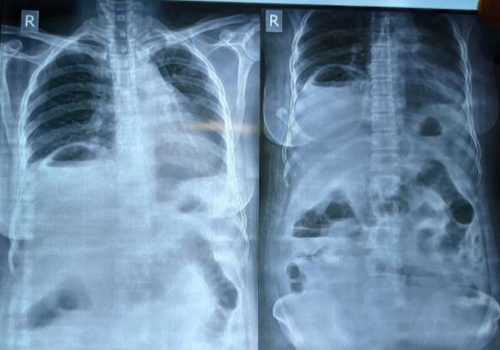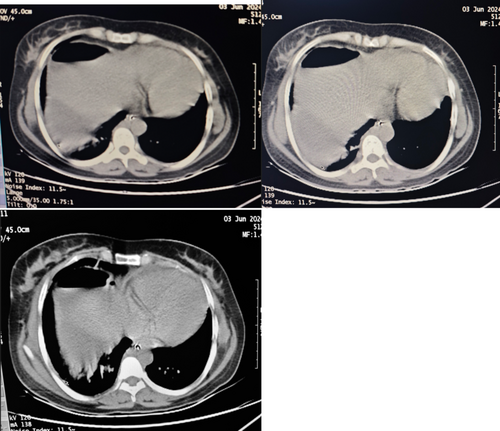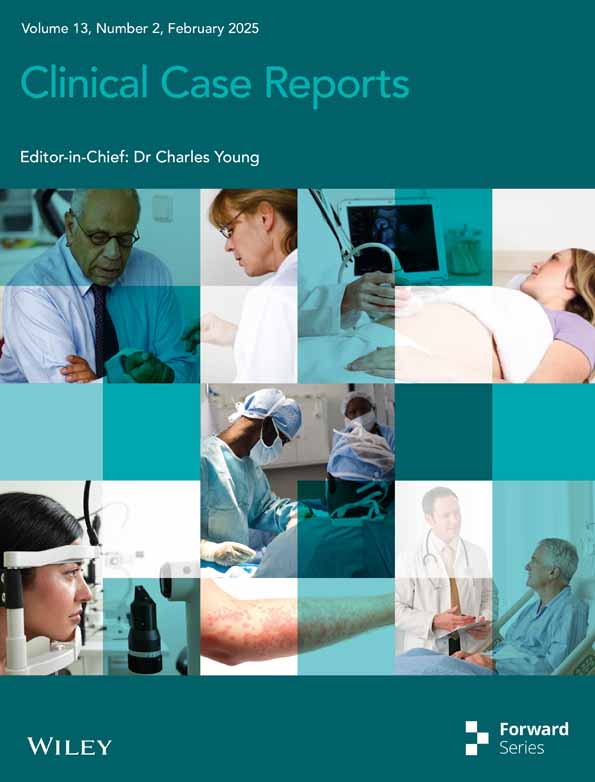A Case of Post-Partum Afebrile Perforated Appendicitis: A Diagnostic Dilemma
Funding: The authors received no specific funding for this work.
ABSTRACT
There are a couple of references in literature reporting the incidence of acute appendicitis during pregnancy, and the incidence rate is 0.4–1.4 per 1000 pregnancies. Acute appendicitis and perforated acute appendicitis in the postpartum period are rare incidences. Fever and abdominal pain are very common symptoms in acute appendicitis. Here, we are presenting a case of postpartum acute perforated appendicitis. A 34-year-old female was admitted in the department of obstetrics and gynecology with abdominal pain and severe abdominal tenderness. The cervical os was dilated, so the patient was taken to the labor room where she delivered a very low birth weight baby at 22 weeks. After delivery, patient developed respiratory distress and there was a sudden deterioration in her condition. She was then shifted to the critical care unit. The case was managed and the patient's respiratory distress lessened but the abdominal pain and tenderness still persisted. Plain radiography was done and it showed “gas under diaphragm.” The CT scan also showed pneumoperitoneum and a decision was taken to perform an emergency laparotomy. On laparotomy, perforated appendicitis was found. Diagnosis of acute abdomen in pregnancy and the early postpartum period is very confusing, but an early diagnosis is always important. In antenatal screening, an ultrasound of the whole abdomen should be mandated in 30+ years old pregnant women. Surgery is the recommended treatment in such cases.
Summary
- This is a rare case of perforated appendicitis following a preterm vaginal delivery. “Gas Under Diaphragm” in perforated appendix is a rare finding. Perforated appendix in postpartum period is also a rare finding.
1 Introduction
Bowel perforation needs an urgent surgical intervention, and it significantly increases the mortality in patients. Bowel perforation has rarely been seen in a postpartum mother [1]. Bowel perforation after a vaginal delivery (VD) is rarer than that after a cesarean section (C-section) [1].
Appendicitis and appendicectomy during pregnancy are uncommon but they are very rare in the postpartum period [2]. In perforated appendicitis, “gas under diaphragm” in plain radiograph is also a very rare finding [3]. Postpartum perforated appendicitis has also been rarely reported. The most common differential diagnoses are peptic perforation and bowel perforation. Other differential diagnoses are Meckel's diverticulitis, ischemic colitis, bowel obstruction, cholecystitis, Fitz Hugh Curtis syndrome, round ligament syndrome, pelvis thrombophlebitis, torsion of adnexal structures etc.
From the early 1900s, surgeons have been publishing papers related to appendicitis during pregnancy, so currently surgeons are well aware of the diagnosis and management of the appendicitis during pregnancy. Babler had published a paper related to this in 1908 [4]. Harris J. Timerman had published a paper in 1942, presenting two cases of postpartum appendicitis [5].
So, here we are presenting a very rare case of postpartum perforated appendicitis, a diagnostic dilemma. The abdominal pain and tenderness can be misinterpreted as labor pain, and the septic peritonitis can lead to a preterm labor and preterm delivery [6].
2 Case Report
2.1 Case History/Examination
A previously healthy 34-year-old female with no previous history of surgery, P1 + 0, was admitted to the department of obstetrics and gynecology of Raiganj Govt Medical College and Hospital with severe abdominal pain. On abdominal examination, the patient had severe abdominal tenderness, and the cervical os was dilated. The vitals and body temperature were within normal limits, and no history of fever was given. No history of recent vomiting was present. There was a diagnostic dilemma, but as the os was dilated, the patient was taken to the labor room. Her antepartum period was uncomplicated, without any history of pre-eclampsia or pregnancy-induced hypertension. She gave birth vaginally to a very low birth weight child at 22 weeks. At day 0, after the delivery, suddenly, the condition of the mother deteriorated, and the patient was shifted to the Critical Care Unit (CCU) where she was found to have hypokalemia and shortness of breath. Eventually, the potassium level was corrected. Still, the abdominal pain and tenderness persisted.
2.2 Methodology
A straight X ray of the abdomen was suggested. There was “gas under diaphragm” (Figure 1). Ultrasound report had shown a 15 × 7.6 cm collection with inter echogenic foci at lower abdomen and pelvis. CT report had shown pneumoperitoneum (Figure 2).


2.3 Conclusion and Result
Emergency laparotomy was done under general anesthesia. This was a case of appendicular perforation at the base of the appendix with a huge collection of pus (approximately 4 Liter). Appendectomy was done, and the base of the caecum was repaired. A drain was given. The drain was removed on the postoperative (POD) day 6. Therefore, we inferred that the septic peritonitis may have led to preterm labor and preterm birth.
Postoperative recovery was uneventful. Flatus was passed within 48 h of the operation. A semisolid diet was given on postoperative day (POD) 3, and the patient was discharged on POD 8. This case has been managed with a collaborative approach of the Department of Obstetrics and Gynaecology and the Department of Surgery of Raiganj Govt Medical College and Hospital, India.
3 Discussion
In 1932, Baer had shown the change in the position of the appendix during pregnancy [7]. The chance of infection followed by perforation can be increased due to this upward movement of the appendix during pregnancy. In cases of appendicitis, fever is a key symptom, but in our case, the patient did not complain of fever.
An England based cohort study has mentioned, “pregnant women during the antepartum period were 35% less likely to be diagnosed with acute appendicitis than the time outside pregnancy, with the lowest risk reported during the third trimester” [8]. The paper also mentioned, “we found no increased risk of acute appendicitis in the postpartum period compared with the time outside pregnancy among women aged 15 and 34 years. However, the risk increased by almost twofold in older women during the later postpartum” [8]. So, it is important to rule out appendicitis in the antepartum period and surgeons should be very cautious with the older women because the chance of appendicitis is increasing with age.
E Moltubak et al. [9] has shown an increase in appendicitis cases during the peripartum and puerperium phases and there is a decrease in the incidence in the third trimester.
Acute appendicitis during pregnancy has an incidence rate of 0.4–1.4 per 1000 pregnancies [10]. The hospital incidence rate of acute appendicitis in pregnancy was 0.09% [11]. Therefore, this needs an urgent diagnosis and intervention as it may also lead to poor neonatal outcomes and a high maternal mortality rate. An early diagnosis is always important. In antenatal visit, ultrasound of the whole abdomen is also necessary along with the FPP mode to rule out any abdominal pathologies. Although bowel perforation, bowel obstruction, and appendicitis are rare cases in pregnancy, proper screening is important, mostly in older females (more than 30 years). Surgery is always recommended as soon as the diagnosis has been made.
Author Contributions
Arindam Halder: conceptualization, data curation, investigation, supervision, writing – original draft, writing – review and editing. Tulika Jha: conceptualization, investigation, methodology, resources, supervision, validation, visualization, writing – original draft, writing – review and editing. Raja Basak: conceptualization, investigation, methodology, resources, supervision, validation, visualization, writing – original draft, writing – review and editing. Samir Roy: conceptualization, investigation, methodology, supervision, validation, visualization, writing – original draft, writing – review and editing. Dattatreya Mukherjee: writing – original draft, writing – review and editing. Aymar Akilimali: validation, writing – original draft, writing – review and editing.
Acknowledgments
We are thankful to the Department of Anaesthesiology and Nursing staffs. The work has been posted in Preprint with the link https://advance.sagepub.com/users/817596/articles/1217835-a-case-of-post-partum-afebrile-perforated-appendicitis-a-diagnostic-dilemma
Consent
Written Consent from the patient has been taken for publication. The case will be used for academic purposes, and the identity of the patient will not be disclosed.
Conflicts of Interest
The authors declare no conflicts of interest.
Transparency Statement
All authors declared that the data in the manuscript are Correct, Honest, and Transparent.
Open Research
Data Availability Statement
All data are available in the manuscript.




